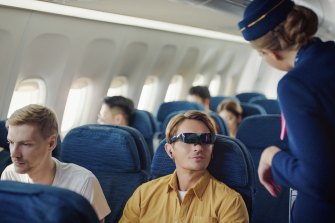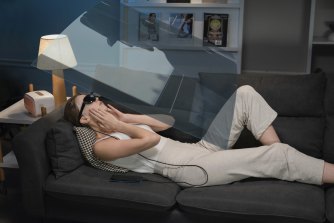TVs you wear on your face have arrived but theyre not quite ready
Putting displays in front of your eyes to mimic the experience of a massive private screen, TCL’s $899 NXTWEAR G Glasses have some serious sci-fi potential. But will they kickstart a new category of wearable TVs, or be relegated to being a forgettable gimmick?
Unlike the smart glasses that were all the rage a few years ago, and were all-but abandoned because they required technology and a willingness to relinquish privacy that didn’t quite exist yet, the NXTWEAR G does not feature cameras or other smarts. It’s a screen that you wear as glasses, which can display content from your attached smartphone, tablet or laptop, giving you the equivalent of watching a 140-inch (357 cm) TV.

TCL’s NXTWEAR G lets you view content from a compatible phone, tablet or laptop on screens directly in front of your face.
I must admit that when I first heard about them, I imagined them to be both better and worse than they actually are. Using them, it’s quite clear that they’re first-generation technology; they’re a bit clunkier than they perhaps should be, and the fit isn’t as good as it could be, but the potential is huge.
Unlike VR goggles, you’re not shut off from the rest of the world. Instead, you can see a significant amount of the world around you, particularly below the glasses. They take up around three fifths of my field of view, which means they’re useful as a compact second screen when working with a laptop on the couch.
I expected to be able to look around and have multiple screens up while using them, but again that’s a VR feature. Having the image stay where it is in the glasses means you can get comfortable at whatever weird angle you want and have the screen stay in the perfect spot. That would be fantastic for someone who has trouble keeping their head still (like with Parkinson’s or a similar disease), or someone recovering from surgery, or if you’re watching something in bed and are particular about your comfortable angles.

The glasses make for the equivalent of a 140-inch screen.
Having to have the glasses plugged in on a relatively short metre-long USB-C cable does reduce its potential uses, and plugging into something like an iPhone or Xbox that doesn’t natively support video over USB-C is problematic. But the longer I use them, the more I wish I had them when I used to spend all my time on long-haul flights. They’d also be so great for watching TV in bed while your partner sleeps without a disturbing light, or for having a big display in a tiny office or while on the move.
The glasses sport full HD resolution, but can display from 4K sources and support 3D content, if you can find it. They also have integrated stereo speakers.
Of course, they’re not perfect. A 140-inch screen sounds much bigger and more engrossing than it really is (it’s more like you’re sitting a reasonable distance from a large screen), and having to rely on the controls of whatever device you’re using means that you can be limited with magnification and navigation.
It’s also not great if you need to wear regular glasses to see. I’m told there is a way to get prescription lenses made for the NXTWEAR G, but that seems like a big commitment for first generation glasses that are very good, but still have a lot of kinks to iron out.
I went into this suspicious of gimmicky technology. But the longer I spend with the NXTWEAR G, the more of a future I can see for wearable screens that aren’t trying to take you out of reality, but merely expand upon it.
There is huge potential in wearable screens, for a lot of applications, once they’re made lighter, more comfortable, and easier to use if you need regular glasses.
Get news and reviews on technology, gadgets and gaming in our Technology newsletter every Friday. Sign up here.
Alice Clarke is a freelance journalist, producer and presenter.
0 Response to "TVs you wear on your face have arrived but theyre not quite ready"
Post a Comment